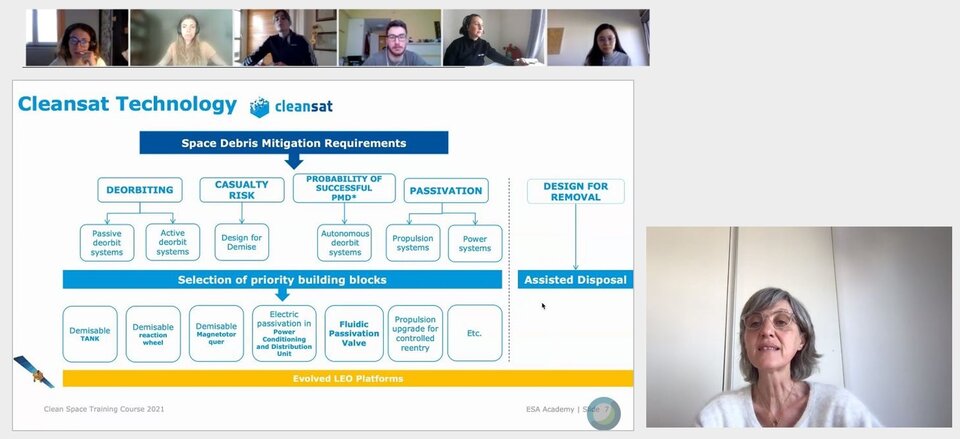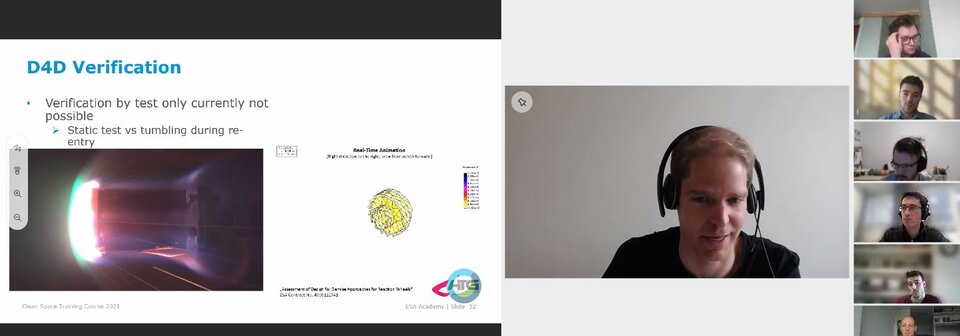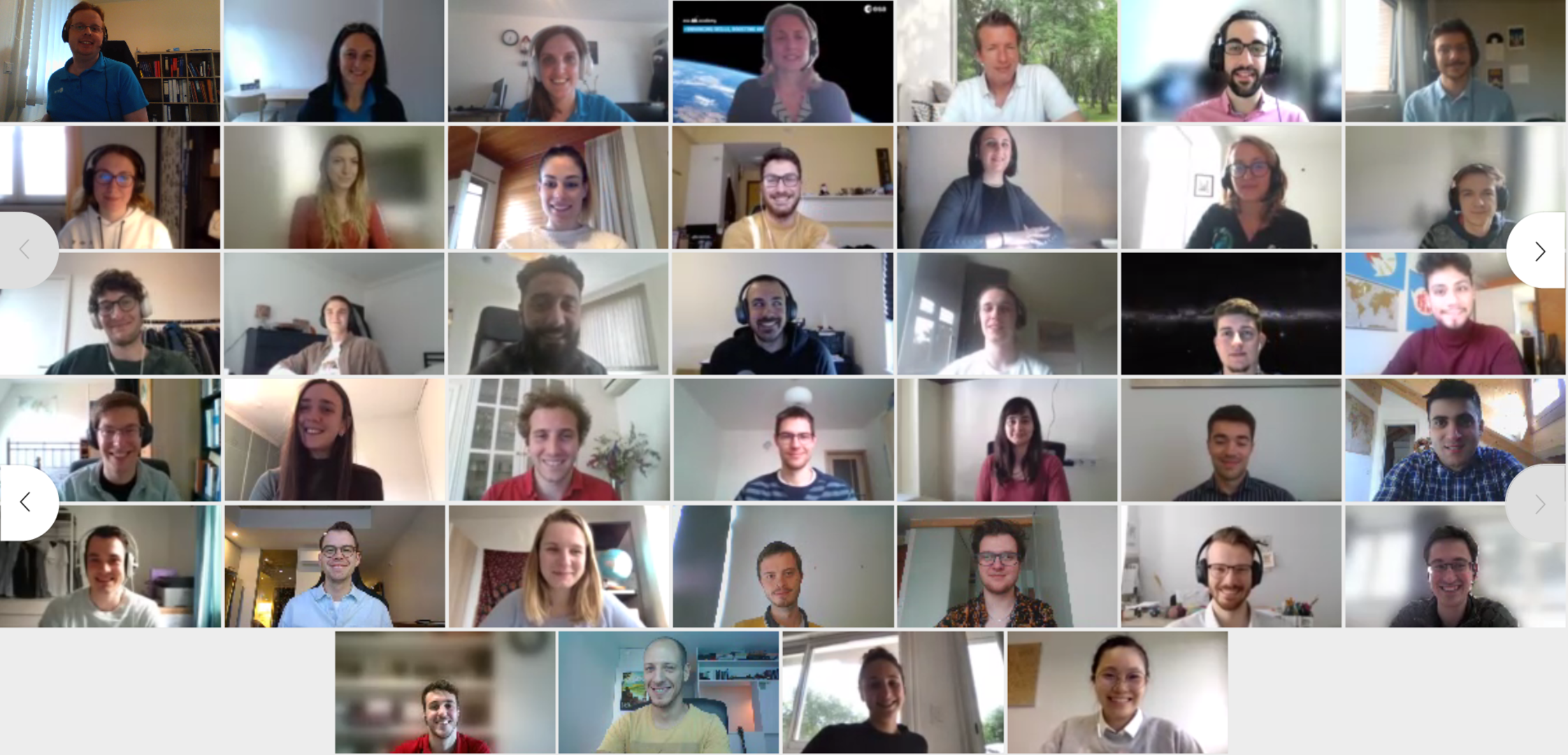Online Clean Space Training Course 2021 challenges university students to clean a “Mega Constellation”
Environmental awareness is increasingly important in every area of our modern world, and the space sector is no exception. ESA’s Clean Space Office was established in 2012 to assess and mitigate the environmental effects of the entire life cycle of space missions. ESA Education Office teamed up with ESA’s Clean Space Office to offer a second edition of the ESA Academy’s Clean Space Training Course , which ran online from 3 to 7 May 2021.
The course’s goal was to offer university students valuable insight into the environmental impact of space missions; and to consider design approaches that are environmentally friendly, do not generate debris, and can remove debris, such as defunct satellites already in orbit. In attendance were 30 university students of 11 different nationalities from ESA Member States and Canada. Lectures were delivered by ESA experts, and an expert from the European Commission. The entire course was held online due to the ongoing COVID-19 pandemic.

The activities of the Clean Space Office fall into three main areas, which the training course mirrored:
- EcoDesign: addressing environmental impacts on Earth and fostering green technologies;
- Management of End-Of-Life: minimising the production of space debris and making future satellites easier to be removed in case of failure of the disposal strategy;
- In-Orbit Servicing: removing spacecraft from orbit and demonstrating in-orbit servicing, such as re-fuelling.
Monday began with the students receiving a warm welcome before being introduced to the training course. They then enjoyed an inspiring and interactive lecture from the Head of the Clean Space Office, who gave an overview of the main challenges faced in the mission to create a more sustainable space environment. “ESA's efforts to protect the environment are really inspiring,” said a French student from Cranfield University. “I’ve been rethinking my personal position on what is actually eco-friendly in space-related topics.”
Next came a fascinating explanation of Life Cycle Assessments, given by an expert from the European Commission. This was followed by a lecture on EcoDesign, where the students were familiarised with the current environmental framework at a worldwide level, and how, at ESA, the Life Cycle Assessment is implemented to quantify and reduce environmental impact. The day concluded with a practical exercise in which the students, divided into groups in virtual break-out rooms, were challenged to apply the knowledge they had gained so far.
Tuesday saw the students introduced to topics related to satellites’ end of life, and space debris reduction. They were fully focussed during immersive lectures covering Space Debris Mitigation Requirements and the implications of these in Spacecraft Design, Re-entry Strategies, and Passivation Techniques. An interactive group project then gave participants the opportunity to practice applying Space Debris Mitigation Requirements. “The highlight of my experience was definitely the group exercises,” said a Canadian Student from Université Laval. “Not only they were fun, but they really helped my comprehension.”

On Wednesday the course continued at pace. An interactive lecture on Design for Demise had the students enthralled, and was quickly followed by a practical group project. Then it was on to lessons centred on In-Orbit Servicing and Close Proximity Operations. The day finished with a lecture offering an overview of the legal and regulatory dimensions of Space Debris Mitigation.
The theme of Thursday was In-Orbit Servicing. Past and potential future missions were covered, from both a system and technology perspective. Emphasis was given to methods of removing spacecraft from orbit. During the lectures it was stressed that the technical and safety standards in this domain need to develop further. Students also discovered how, in the near future, servicing missions will be carried out without the direct need for humans in-the-loop. Throughout the day different techniques for Active Debris Removal were presented, with particular focus on the use of robotics for capture.

The students were then given their final group project assignment: “Clean the Mega Constellation!” Each group received a different mega-constellation assignment, and was tasked with investigating ways to design and operate them in an environmentally friendly manner. They needed to comply with space debris mitigation guidelines, remove failed spacecraft, and take into account the environmental impacts on Earth. "Inspiring experts were open for every question and shared their valuable experiences with us,” said a German student from Technical University of Munich. “What I enjoyed the most was working in an international team on our own ideas of how to clean the mega constellation!"
The final day began with a lesson on Design for Removal. This was immediately followed with time for work on the group projects, building up to the students presenting their results to the experts. After the training course, the students received their certificate of participation and course transcript, with these documents they will be able to claim ECTS credit(s) from their respective universities. These 30 students are now equipped with skills and knowledge to take them into their future careers in space with awareness of their impact on our precious planet.
- To find more information about upcoming and future ESA Academy training opportunities, please check: http://www.esa.int/Education/ESA_Academy/Current_opportunities
- Contact: tlp@esa.int


